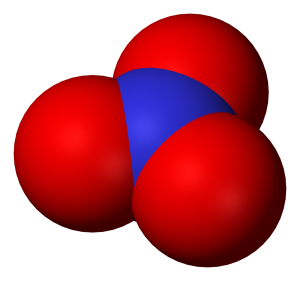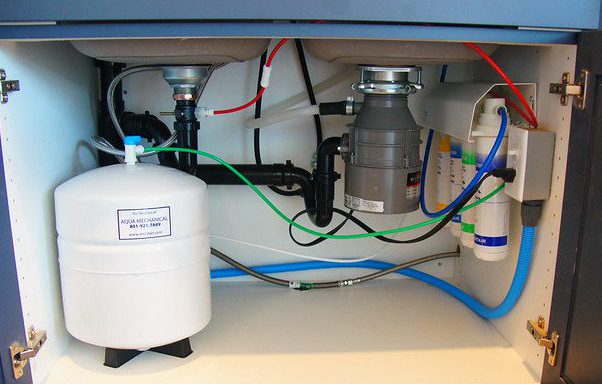
What is it?
Nitrate is a chemical compound composed of nitrogen and oxygen. Naturally occurring in low concentrations within the soil, water, and air, nitrate plays a vital role in plant and microbial life cycles. However, excessive amounts can lead to algal blooms in surface water bodies and contamination of drinking water sources.
Where does it come from?
Human activity can produce extra nitrate in the environment. Turf grass fertilizer, farm fertilizer, septic systems, and livestock runoff contribute to increasing nitrate levels. This compound is very mobile in water and soil, using rain and irrigation water to travel to surface water bodies and percolate through soils into groundwater (Sigler and Bauder). Background levels of 2-4 mg/L are considered normal. Concentrations above that can be an indication of potential groundwater contamination that might carry more hazardous compounds along with it. For example, if you suspect the nitrates from your well could be from nearby agricultural crop fertilization, you might consider testing that supply for common pesticides also used in the industry (Swistock). Alternatively, if you suspect it is sourced from your septic tank, you might test your water for coliform bacteria, to make sure that your septic effluent isn’t impacting your well.
Associated health impacts?
In general, healthy adults don’t tend to show negative reactions to elevated levels of nitrates in water, however, the Environmental Protection Agency (EPA) has established limits for public supply. Municipal water should not contain more than 10 mg/L. This standard was established to protect newborns, pregnant mothers, and adults with certain diseases or illnesses (Swistock). Infants cannot process high levels of nitrate. It changes form in their bodies and inhibits the blood’s ability to capture oxygen. This leads to a disease called blue baby syndrome that could result in suffocation if the symptoms are not identified in time (Sigler and Bauder). However, nursing mothers don’t seem to pass the issue along through breast milk. If you are concerned with elevated nitrate in your drinking water supply, it is best to err on the safe side and prepare baby formula with bottled water. In addition, pregnant mothers should also be careful. Some studies have found correlations between lower birth weight babies and elevated nitrate.
How can it be treated?
As they say: “An ounce of prevention is worth a pound of cure”. Ideally, identification and mitigation of the potential source on your property is the best solution. This could involve septic tank pumping, composting manure, reducing fertilizer application, protecting the wellhead from flooding, and even redrilling your well.
If you determine that the source of nitrate is not on your property, there are treatment technologies that you can use to address the issue. The most common treatments are ion exchange, reverse osmosis, and distillation.
Ion exchange
Ion exchange is the same technology used to treat hardness in water, however, the resin exchanges chloride with nitrate instead of sodium with calcium. This system is costly, requires regular maintenance, and might also be less effective if other contaminants that share similar chemical properties are present in the water (Swistock). This media is also found in some cartridge-style filters, this option is effective for smaller water volumes though the media doesn’t refresh itself like traditional ion exchange technology so regular filter replacement is paramount in this application.
Reverse osmosis

“24956602452_e0bbaf5f57_c” by Aqua Mechanical is licensed under CC BY 2.0
Reverse Osmosis uses pressure to push water through a superfine membrane allowing clean water to pass and holding contaminants behind. This system needs relatively clean water as a source, so it is commonly combined with pre and post-treatment or sold as a multi-stage filtering unit using reverse osmosis as one of the stages. These multi-stage systems are very useful for treating not just nitrate but a spectrum of contaminants. They are also versatile installation options. Smaller systems can be installed behind the refrigerator or under a sink, and larger systems can be installed to treat the entire house. The downsides of this system include increased water use, regular filter replacement, and treatment volume limitations. These systems are said to remove between 80 and 90 percent of nitrate (Swistock). Though that is substantial removal, if the source water is above 100 mg/L of nitrate, the filtered water could still contain nitrate above the EPA established standard of 10 mg/L.
Distillation
Lastly, distillation is a method that heats water to its boiling point and then allows it to cool and condense into a separate container. This process removes many contaminants and the heat kills bacteria. These systems are mostly used as stand-alone countertop devices and not for whole-house treatment. This is seen by some as a disadvantage and as an advantage by others. No plumbers or technicians are needed to purchase, install, and operate this system and many folks travel with them to get relatively consistent water quality wherever they go. Disadvantages of this system are limited treatment volumes (produces only a couple gallons a day), increased electricity use, and initial cost.
Though nitrate and its health impacts are mostly limited to infants and pregnant mothers, the long-term impacts of drinking water with elevated levels are mostly unknown. Therefore, do your best to consume water with decreased nitrate levels. If you are curious about nitrate levels in your water, you can check your consumer confidence report (CCR) if you purchase municipal water or get your water tested by a certified laboratory if you have well water. If you want to know more about laboratory options, feel free to contact your local extension office or Department of Health and they will be happy to help.
Sign up for the UF/IFAS Marion County Water Resources Newsletter!
Works Cited
Sigler, Adam, and Jim Bauder. “Nitrate plus Nitrite as N – MSU Extension Water Quality | Montana State University.” MSU Extension Water Quality – MSU Extension Water Quality | Montana State University, Montana State University Extension Water Quality Program, https://waterquality.montana.edu/well-ed/interpreting_results/fs_nitrate_nitrite.html.
Swistock, Bryan. “Nitrates in Drinking Water.” Nitrates in Drinking Water, Penn State Extension, 27 Aug. 2015, https://extension.psu.edu/nitrates-in-drinking-water.
 0
0
